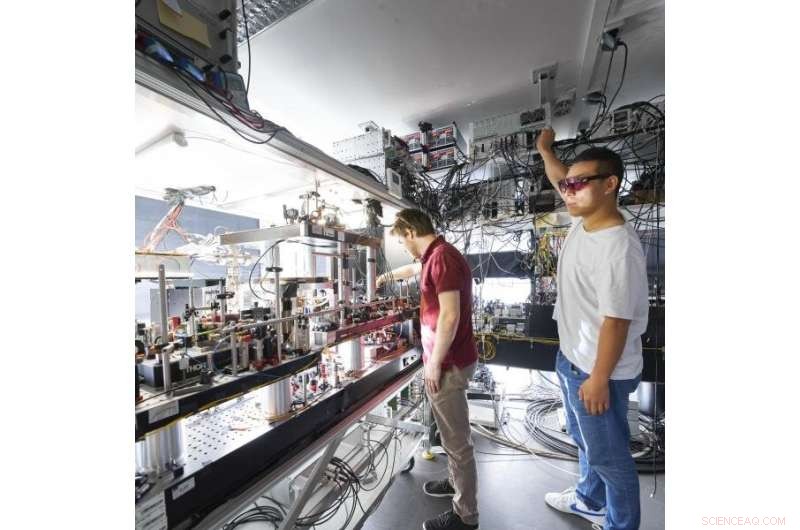
Esquemático del montaje experimental. En cada nodo, ubicado en edificios separados por 400 m, un solo 87 El átomo de Rb se carga en una trampa de dipolo óptico. Ambos átomos se excitan sincrónicamente al estado 5 2 P3/2 |F′=0, mF′ =0⟩ para generar un enredo átomo-fotón en el decaimiento espontáneo posterior. Los fotones individuales emitidos a una longitud de onda de 780 nm se recolectan utilizando objetivos de alta apertura numérica y se acoplan en fibras monomodo que conducen a los dispositivos QFC. Allí, se convierten a longitud de onda de telecomunicaciones (λ = 1,517 nm) por la generación de diferencia de frecuencia en una guía de ondas de niobato de litio con polos periódicos (PPLN) ubicada en una configuración tipo interferómetro Sagnac, tal configuración mantiene completamente el estado cuántico de polarización del fotón. Los fotones convertidos son guiados a una estación intermedia por enlaces de fibra con longitudes de hasta 16,5 km, donde un BSM intercambia el enredo con los átomos. Después de generar con éxito el entrelazamiento átomo-átomo, los átomos se analizan de forma independiente mediante un pulso de lectura cuya polarización, establecida por una placa de media onda (HWP) y una placa de cuarto de onda (QWP), define la configuración de medición. PC, controladores de polarización. Crédito:Naturaleza (2022). DOI:10.1038/s41586-022-04764-4
¿Una red en la que la transmisión de datos es perfectamente segura contra la piratería? Si los físicos se salen con la suya, esto se hará realidad algún día con la ayuda del fenómeno mecánico cuántico conocido como entrelazamiento. Para las partículas entrelazadas, la regla es:si mides el estado de una de las partículas, automáticamente conoces el estado de la otra. No importa qué tan lejos estén las partículas entrelazadas entre sí. Este es un estado de cosas ideal para transmitir información a largas distancias de una manera que hace que sea imposible escuchar a escondidas.
Un equipo dirigido por los físicos Prof. Harald Weinfurter de LMU y Prof. Christoph Becher de la Universidad de Saarland ahora ha acoplado dos memorias cuánticas atómicas a través de una conexión de fibra óptica de 33 kilómetros de largo. This is the longest distance so far that anyone has ever managed entanglement via a telecom fiber.
The quantum mechanical entanglement is mediated via photons emitted by the two quantum memories. A decisive step was the researchers' shifting of the wavelength of the emitted light particles to a value that is used for conventional telecommunications. "By doing this, we were able to significantly reduce the loss of photons and create entangled quantum memories even over long distances of fiber optic cable," says Weinfurter.
Generally speaking, quantum networks consist of nodes of individual quantum memories—such as atoms, ions, or defects in crystal lattices. These nodes are able to receive, store, and transmit quantum states. Mediation between the nodes can be accomplished using light particles that are exchanged either over the air or in a targeted manner via fiber optic connection. For their experiment, the researchers use a system comprised of two optically trapped rubidium atoms in two laboratories on the LMU campus. The two locations are connected via a 700-meter-long fiber optic cable, which runs underneath Geschwister Scholl Square in front of the main building of the university. By adding extra fibers on coils, connections of up to 33 kilometers in length can be achieved.
A laser pulse excites the atoms, after which they spontaneously fall back into their ground state, each thereby emitting a photon. Debido a la conservación del momento angular, el espín del átomo se enreda con la polarización de su fotón emitido. These light particles can then be used to create a quantum mechanical coupling of the two atoms. To do this, the scientists sent them through the fiber optic cable to a receiver station, where a joint measurement of the photons indicates an entanglement of the quantum memories.

Credit:Jan Greune
However, most quantum memories emit light with wavelengths in the visible or near-infrared range. "In fiber optics, these photons make it just a few kilometers before they are lost," explains Christoph Becher. For this reason, the physicist from Saarbrücken and his team optimized the wavelength of the photons for their journey in the cable. Using two quantum frequency converters, they increased the original wavelength from 780 nanometers to a wavelength of 1,517 nanometers.
"This is close to the so-called telecom wavelength of around 1,550 nanometers," says Becher. The telecom band is the frequency range in which the transmission of light in fiber optics has the lowest losses. Becher's team accomplished the conversion with an unprecedented efficiency of 57%. At the same time, they managed to preserve the quality of the information stored in the photons to a high degree, which is a condition of quantum coupling.
"The significance of our experiment is that we actually entangle two stationary particles—that is to say, atoms that function as quantum memories," says Tim van Leent, lead author of the paper published in Nature . "This is much more difficult than entangling photons, but it opens up many more application possibilities."
The researchers think that the system they developed could be used to construct large-scale quantum networks and for the implementation of secure quantum communication protocols. "The experiment is an important step on the path to the quantum internet based on existing fiber optic infrastructure," says Harald Weinfurter. On the way to quantum networks